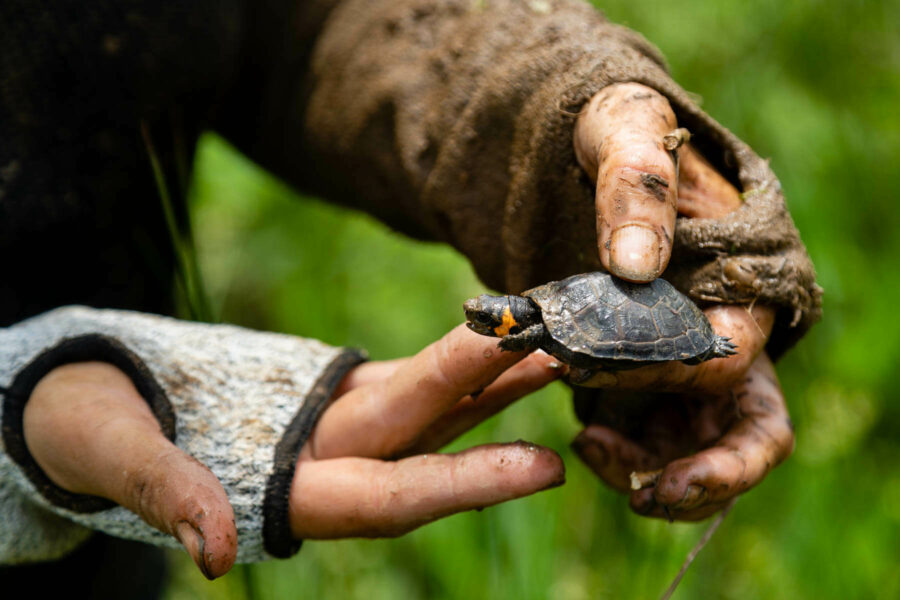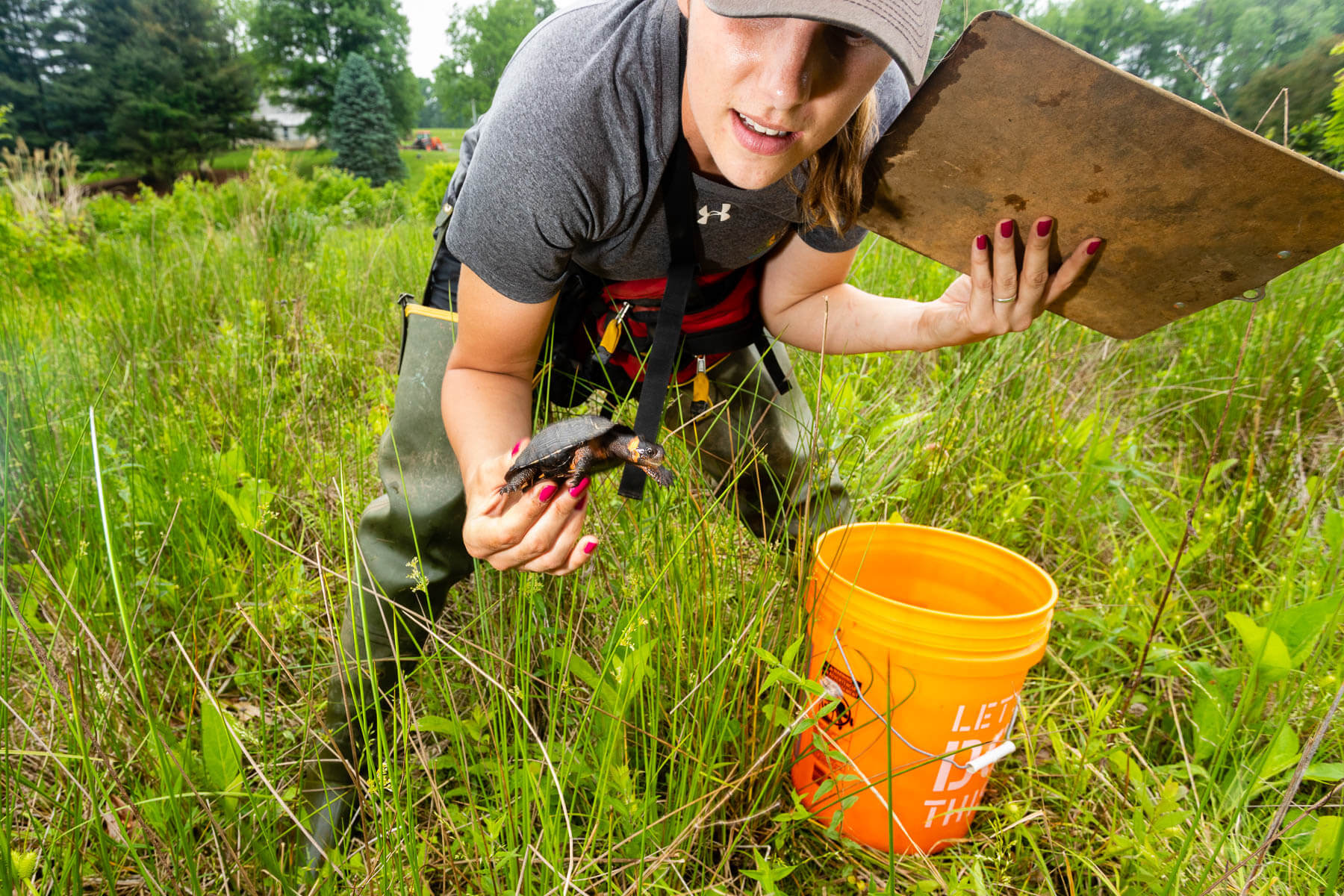Searching for bog turtles in a disappearing habitat
Vanishing wetlands threaten these tiny turtles

It’s a warm morning in late May when a group of surveyors, led by Beth Schlimm from the Maryland Department of Natural Resources (DNR), gathers at a parking lot in Harford County, Maryland. The group disinfects their hip waders and pulls on gloves and thick protective sleeves before heading to a nearby wetland in search of the elusive bog turtle.
The bog turtle, which can be identified by the orange or yellow patches on each side of its head, is North America’s smallest and rarest turtle. Fully grown, they measure under four and a half inches in length. They’re also listed as federally threatened under the Endangered Species Act.
Since the bog turtle’s range includes parts of northern Maryland, DNR is involved in a variety of bog turtle conservation activities, including regular surveys of potential bog turtle habitat. Some of the best sites, like this one in Harford County, are surveyed once or twice each year.
In search of bog turtles
Upon reaching the wetland, Schlimm finds the first turtle almost immediately. The turtle is sitting out on the surface amidst the grasses, what the surveyors call “cryptic basking.” The group does a quick walk-through of the two-acre wetland and then begins searching through the mud for tunnels and turtles, also known as “muddling.”
Like many bog turtle habitats, the Harford County site is a spring-fed wetland. Bog turtles need cool waters, open areas for basking and a high water table. They prefer low, grassy vegetation with dense, tufted sedges for nesting and shallow water channels for hiding.
Development and wetland drainage has reduced the amount of these types of wetlands, playing a large role in the bog turtle’s decline. These conditions are also very difficult to replicate, making it vital to preserve the areas that are left.
Bog turtles will most often be hiding in tunnels about the size of your first, so surveyors reach deep inside in hopes of finding one. “You do develop a search image for them,” explains Schlimm. “It’s more about feel. You’re lucky if you find one out in the open like that.”
As I discovered first-hand, this is also a good way to find a snapping turtle. Snapping turtles are potential predators for bog turtles, especially juveniles or eggs. Bog turtles generally stick to shallower areas to try to avoid the snappers, which usually prefer deeper waters.
Throughout the morning, the sounds of birds and wetland animals are interrupted by the occasional call of “Found one!” Schlimm brings around a bright orange bucket to collect each found turtle. Surveyors record GPS coordinates and place a brightly colored ribbon where each turtle is found so they can be returned to the right spot at the end of the day.
 Beth Schlimm, a biologist with the Maryland Department of Natural Resources (DNR), discovers a turtle while walking the survey site. (Photo by Will Parson/Chesapeake Bay Program)
Beth Schlimm, a biologist with the Maryland Department of Natural Resources (DNR), discovers a turtle while walking the survey site. (Photo by Will Parson/Chesapeake Bay Program)
Each turtle is identified by the location of notches along its carapace, or upper shell. Several of the turtles have been caught and recorded in prior years, allowing DNR to get a sense of how each turtle is faring over time. Throughout the years, more than 80 different bog turtles have been recorded at the site.
Schlimm takes down a number of stats for each turtle, including weight, length and carapace height. On the younger turtles, she can count growth rings on the shell plates, or scutes, to determine the turtles age. The rings wear down as the turtles age, making it difficult to age older turtles.
She also notes any injuries. One turtle is found with a long crack down the middle of its carapace, but it seems to have recovered well. “They’re tough little turtles for how small they are,” she says. They’ve found turtles before with cracked shells, missing claws or even missing limbs, but many are able to adapt well.
Vital habitat
Bog turtles don’t need a large area to maintain a decent population. Many of the wetland sites surveyed by DNR are only around half an acre in size. While some of the wetlands are on conserved lands, most are owned by private landowners, making partnership critical to preserving bog turtle habitat.
“For a lot of these landowners, [the wetlands are] just unusable space,” says Schlimm. DNR works hard to maintain good relationships with the landowners and help them understand the value of their wetlands. Wetlands are vital habitat not just for bog turtles, but for many of the endangered and threatened species in the Chesapeake Bay watershed.
In addition to providing habitat, wetlands also improve water quality. These lands act as a sponge, trapping and absorbing stormwater and polluted runoff. This gives water a chance to naturally filter as the trees and plants slow the flow and absorb nutrients and chemical contaminants.
Because of these benefits, the Chesapeake Bay Program set a goal in the Watershed Agreement to create or re-establish 85,000 acres of wetlands and enhance the function of 150,000 acres of degraded wetlands by 2025.
The future for bog turtles
By the end of the day, the group had found 11 turtles. The largest, dubbed “Big Momma,” weighed 190 grams (0.42 pounds) and was carrying eggs. The smallest was a tiny one-year-old, so light it needed to be weighed with a more sensitive spring scale. One turtle caused some concern with its loud wheezing breath, and was slightly underweight.
Schlimm ended the survey early in the afternoon so she could bring the sick turtle to the Maryland Zoo, where the zoo’s hospital could check on it. He was given a round of antibiotics for a potential respiratory infection and monitored by veterinarians for 10 days. Once he completed his medication and gained some weight, they felt he was healthy enough to be released.
Surveys like the ones DNR conducts are an important way to measure how the bog turtle population is doing, but educating landowners about how they can help is just as important for the turtles’ survival and expansion. More wetlands not only mean more potential habitat for bog turtles, but cleaner waterways and a healthier Chesapeake Bay.
Learn more about the value of wetlands.

Comments
That was a very sad story! My heart goes out to those poor turtles!
Hi Stephanie, Thanks for reaching out and for your interest in your pond and wetland! Turtles of any kind are exciting and the following link from MD Department of Natural Resources can help identify what you may have: http://dnr.maryland.gov/wildlife/Pages/plants_wildlife/herps/index.aspx. Bog turtles have a characteristic “ear patch” that is usually yellow—this is unique and will help you identify if they are bog turtles. If you think your turtles may be bog turtles, please reach out to the U.S. Fish and Wildlife Service: https://www.fws.gov/chesapeakebay/contact.html.
We have a farm with a 7 acre spring fed pond in Elkton, MD. We have turtles but are unsure what kind(s) they are. Please let me know if we can help the bog turtle population! Thank you!
Thank you!
Your comment has been received. Before it can be published, the comment will be reviewed by our team to ensure it adheres with our rules of engagement.
Back to recent stories